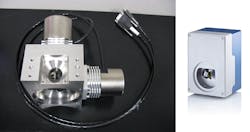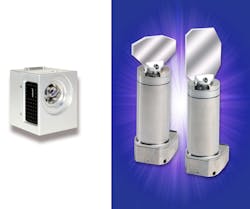PRODUCT FOCUS: GALVANOMETER SCANNERS: What you need to know to buy a galvo-positioner
Galvanometer scanners are found wherever laser beams are steered: materials processing, laser light shows, manufacturing, packaging, cutting, marking, welding, and numerous other applications. The market has seen some significant developments in the past year.
Originally, galvanometric devices measured the electric current flowing through a coil in a magnetic field–when current flows the coil experiences a torque proportional to the current. These devices were at the heart of all moving coil meters. In the laser world, the term "galvanometers," also known as galvoscanners, galvopositioners, or galvos, refers to a high-resolution rotary motor with a mirror mounted, instead of a pointer. And whereas nanopositioners (see Laser Focus World, May 2010, p. 75) primarily move a stage with high precision but can also steer laser beams, galvopositioners are less precise and therefore less expensive solutions for beam steering. Very low-precision galvos may simply be called optical scanners, like those found in grocery store scanners. China manufactures mainly low-precision galvoscanners, one application of which is laser light show systems where speed is the primary performance factor (see Fig. 1).
Galva-what-now?
A galvo system consists of three main components: the motor or galvanometer, the mirror or mirrors, and the "servo"—the driver board that controls the system. These three parts and their tradeoffs drive the performance of the system. "System positioning performance used to be measured in milliseconds," says Red Aylward, president, Cambridge Technology Inc. (CTI, Lexington, MA). "As galvo systems have reached 100 μs step times and root-mean-square (rms) frequencies greater than 2 kHz, many of the design rules that used to apply are no longer adequate."
The galvo part, an actuator that manipulates the mirror, comes in two configurations for today's high-performance systems, says Aylward. The moving magnet configuration, in which the magnet is part of the rotor and the coil is part of the stator (the stationary part of the motor), tends to have higher system-resonant frequencies–a desirable trait in galvos that ranges from single to more than 20 KHz (see Fig. 2, left). The other is the moving coil configuration where the coil is integral to the rotor and the magnet is part of the stator, which optimizes torque-to-inertia ratio and torque efficiency. A third type of actuator, the original moving iron configuration, had an iron rotor that offered high torque but limited high-speed performance and positioning accuracy.According to Monika Herzog, marketing manager at Raylase AG (Wessling, Germany), a two-axis (2D) galvanometer scanner moves two mirrors along the x and y directions to deflect a laser beam to any position within the two dimensions, known as the "marking field." A beam input unit accepts input only from compatible lasers. Depending on the type of laser, the beam output is either open or fitted with a protection window or an f-theta lens—a scanning lens that provides a flat field at the image plane of the scanning system (see Fig. 2, right).
In cases where a suitable flat-field lens is not available, the laser focus must be positioned in three dimensions (3D), or x, y, and z. In a 3D scanning unit, the laser beam first encounters a moving lens, from which it diverges to one or two focusing lenses. The beam is then directed by a set of x and y mirrors moved by the galvanometer scanners. The orthogonal arrangement of the x and y mirrors directs the beam down toward and over the length and width of the working field.
Positioning and servos
To measure the exact angular position of the mirrors mounted to the shaft, galvanometers are equipped with an extremely precise position detector, either an analog detector (which may be optical or capacitive), or a digital encoder. Explains Robert Milkowski, president, Nutfield Technology (Hudson, NH), "Capacitive detectors have a very good signal-to-noise ratio and good linearity, but the weight of the detector impacts its speed. Optical detection galvos are the inverse of capacitive; the upside is speed, while the downside is increased noise and less linearity."
Servo technologies can also be either analog or digital. Closed-loop galvos provide feedback to the servos, which can be analog PID-type driver boards or, within the past year, fully digital state-space driver boards. According to Aylward, "A closed-loop galvo is a limited-angle actuator (typically less than 40° of rotation) with an integral angular position detector, all designed for very fast (100 μs) and very accurate (single micro-radian repeatability) positioning when driven and controlled with a servo-control driver board. Open-loop galvos are generally lower accuracy and lower cost. And resonant scanners are also available for higher-speed applications up to 16 KHz. Complete closed-loop subsystems are the most common (also referred to as scan heads), with two mounted x-y galvos, two mirrors, and two servos packaged in a box and lens-ready for lots of applications like materials processing (the biggest app)."
With the recent advances in digital control, galvanometer systems are often divided by whether their position sensing technology and the driver-board technology are analog or digital. "The world of laser scanning is now moving to fully digital systems," says Dominik Brunner, sales manager at Scanlab AG (Puchheim, Germany; see Fig. 3, left).Yet analog systems will remain on the market because they offer price for performance, says Milkowski at Nutfield. "For the average user, analog servos do the job at a lower cost. But they typically need to be hand-tuned by a technician. Digital servos do offer auto-tuning but offer little performance benefit. Digital position detectors offer more precision but are more expensive" (see Fig. 3, right).
Two servo configurations commonly compete to balance speed and accuracy requirements, says Aylward. An integrating servo, or Class 1, uses integrated position error to settle to the highest level of positioning accuracy with the least angular error. Applications that value precision over speed often rely on integrating Class 1 servo controllers. A nonintegrating servo, or Class 0, can provide higher system speeds because it avoids the integration time. This configuration is used when some precision (up to approximately 100 μrad) is sacrificed to increase the speed, often by 10% or more. Many of the highest-speed applications rely on nonintegrating Class 0 servos.
The categorization of galvanometers among manufacturers can be confusing. Different manufacturers categorize galvos differently, such as by application, closed-loop versus open loop, or technology type. At CTI, galvos are broken down by actuator type (moving magnet or moving coil) and type of position detector (capacitive, optical, or digital). "The most popular today is the moving magnet with an optical position detector. Digital position detection is the newest advance for applications requiring extreme accuracy but it comes at a price premium for that added accuracy," says Aylward. These digital systems are ideal for applications that require a particularly high level of thermal and positional stability, or dither.
Nutfield Technology divides the field into three categories by type: position detector, servo, and suspension. Suspension technologies are divided into bearing- or flexure-based systems. In bearing-based suspension systems, adequate for 90% of applications, the rotor is mounted using a classic round bearing technology. In flexure suspension systems, the rotor is mounted using steel flat springs, improving precision in imaging applications.
Where to start?
The Raylase web site helps narrow down a customers' needs with some key questions. "We start by asking what industry focus a customer has: automobile, semiconductor, packaging, medical, and so on," says Herzog. "Then, what application: marking, cutting, perforating, drilling, welding, engraving, prototyping, tooling, and so on. We ask what nanometer of wavelength and wattage of power you are working with (which depends on your laser), what field size, and whether or not the target is moving. Are you more concerned with speed, low drift, or both? Then we find out whether you need a package including electronic board and software."
Working fields range from 100 × 100 mm on the small end to 1.5 × 1.5 m on the large end. Spot sizes down to 300 μm are possible with CO2 lasers in a 500 × 500 mm working field for fast processing of different kinds of material. Another application is processing of objects with an uneven surface, addressed by the new Focus-Shifter family of products at Raylase, which allows the focus of the laser beam to move along the z-axis of the target.
Manufacturers agree that the top buying criteria are speed, accuracy, cost, and size. Speed or step response time is inversely related to the galvo/mirror inertia and resonant frequency, and is typically specified as the time to move to 99% of 0.1° (mechanical) positioning move. Maximum rms frequency or repetition rate is related to both the bandwidth and the capability of the galvo to dissipate the heat of high currents, rate, and duty cycle. Accuracy is given in terms of short-term repeatability, or the range of error that occurs when the galvo is repetitively commanded to the same position. For users doing alpha-numeric character marking, speed can be measured in characters per second. Generally, the higher the accuracy of a galvo system, the higher the cost. A larger beam and galvo reduce the speed and increase the cost.
Nonlinearity is another accuracy consideration involving the error difference from a perfectly linear slope of the command voltage to scan-angle position over the scan range (for example, when the command signal for -10 V gives -20°, 0 V gives 0°, and 10 V gives +20°). Size of the system is another important concern. Generally, the bigger the beam and the mirror to be deflected, the larger the galvo must be to deliver higher torque fast enough. Lifetime is also a consideration, given in terms of cycles (perhaps in the billions). Another factor to consider in very high-precision applications is thermal drift, with both offset and scale components—the position error related to changes in environmental temperature and over time.
Editor's note: The "Product Focus" series is intended to provide a broad overview of the product types discussed. Laser Focus World does not endorse or recommend any of the products mentioned in this article.

Valerie Coffey-Rosich | Contributing Editor
Valerie Coffey-Rosich is a freelance science and technology writer and editor and a contributing editor for Laser Focus World; she previously served as an Associate Technical Editor (2000-2003) and a Senior Technical Editor (2007-2008) for Laser Focus World.
Valerie holds a BS in physics from the University of Nevada, Reno, and an MA in astronomy from Boston University. She specializes in editing and writing about optics, photonics, astronomy, and physics in academic, reference, and business-to-business publications. In addition to Laser Focus World, her work has appeared online and in print for clients such as the American Institute of Physics, American Heritage Dictionary, BioPhotonics, Encyclopedia Britannica, EuroPhotonics, the Optical Society of America, Photonics Focus, Photonics Spectra, Sky & Telescope, and many others. She is based in Palm Springs, California.


